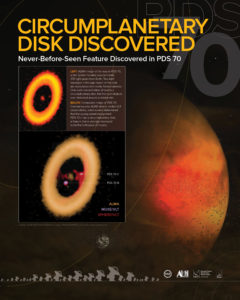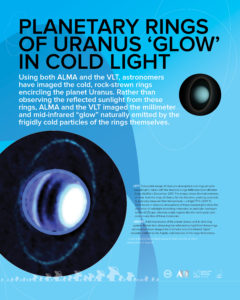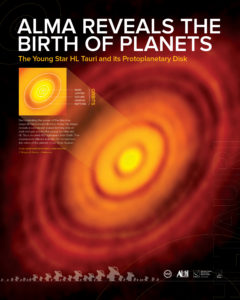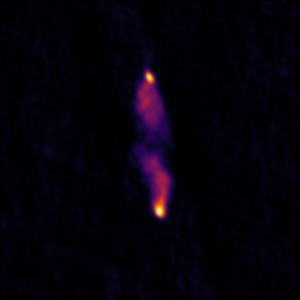Never-before-seen feature discovered in PDS 70


Salt Discovered Around Massive Young Star poster
ALMA has detected sodium chloride emanating from the dusty disk surrounding ORION SOURCE I

Star Formation Across the Universe Poster
Physics at High Angular resolution in Nearby Galaxies survey studies Star-Forming clouds in disk galaxies

Planetary rings of Uranus Poster
Using both ALMA and the VLT, astronomers have imaged the cold, rock-strewn rings encircling the planet Uranus. Rather than observing the reflected sunlight from these rings, ALMA and the VLT imaged the millimeter and mid-infrared “glow” naturally emitted by the frigidly cold particles of the rings themselves.

HL Tau – ALMA Reveals the Birth of Planets Poster
Demonstrating the power of the Atacama Large Millimeter/submillimeter Array, this image reveals a spectacular planet-forming disk of dust and gas around the young Sun-like star HL Tauri, located 450 light-years from Earth. The superposed ellipses indicate, for comparison, the orbits of the planets in our Solar System.

A Universe Full of Radio Galaxies
Radio galaxies are a subclass of active galactic nuclei (AGN) and, in most cases, display what is known as a “core-jet-lobe” morphology. A supermassive black hole, accreting matter at the galaxy’s core, launches material out at the poles, forming two jets of highly energetic particles. These jets can travel immense distances before spreading out into massive, radio-emitting lobes. The structure of these galaxies and their environments will give astronomers clues into how they form stars throughout the history of the universe.
Millions of radio sources will be imaged with the Very Large Array Sky Survey (VLASS). By taking this extragalactic census, a statistically significant population will begin to form. An ambitious radio survey like VLASS provides the astronomical community with a crucial piece of the puzzle in the electromagnetic spectrum, comparing data to the ultraviolet, optical, infrared, and sub-millimeter. Coordinates for this celestial object are: 09h 36m 01.7s -32d 37m 22.6s.





